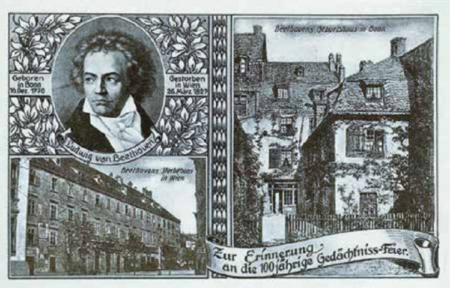A Beethoven Journey from a Cellist’s Perspective
By Yehuda Hanani

Beethoven by Andy Warhol
While on a tour of Germany some years ago, I made a pilgrimage to Beethoven’s home in Bonn an undistinguished modest house, with low ceilings and squeaking floorboards. On display were faded letters; second-rate portraits; his walking cane, with cracked, yellowing, ivory handle; crude hearing aids – hearing horns, hand-fashioned out of copper; his will, in which he made last-minute changes; his death mask, etc. The prevailing feeling was one of dullness, lifelessness and decay. Only one room was abuzz with excitement: the souvenir shop downstairs, where tourists were trying out colorful Beethoven scarves, Beethoven chocolates, penicil sharpeners with the Ninth Symphony on them, shirts and towels imprinted with the late quartets, miniature busts, and other trinkets with shrill, commercial dissonance.
Both historicizing and commercializing attempts miss the mark. The more we probe his troubled life, the clearer the message: “The real me, the best of me, has been transformed into music.” The physicality of Beethoven, the squalor of his apartment, his short temper and absentmindedness, his isolation and his being a social “misfit,” even before deafness set in – all only stand in contrast to his work. They are the shell, the leftovers of a life given over entirely to his art. He is to be found alive and vibrant in the architectural marvels-in-time of his work – in the dramatic chiaroscuro of roughness and tenderness, majesty and playfulness, the rage and the humor, at times Olympic and Promethean, at others mischievous and childlike, covering the spectrum of human experience and aspiration.

Old German graphic showing Beethoven’s home.
The nineteenth century put him on a pedestal as a heroic, romantic loner, challenging his fate and triumphing over adversity, which in a reversal of the Pygmalion story, codified his humanity and froze him into a stylized bust. Modern day social scientists and psychobiographers have attempted to demythologize him, setting him against the political and economic conditions of his era, and pronouncing him a flawed, disturbed person. They would have done better listening to a symphony, a string quartet or one of the sonatas which so intimately and revealingly tell the story of his inner journey – a musical diary, evolving like Rembrandt’s chronicle of self-portraits.
The piano/cello sonatas cover a good distance of this journey from opus 5 to opus 102. In the early to sonatas, we encounter him as a young, self-confident artist, still working within the forms of the day. We can see clearly the influence of Haydn (slow introductory movements, rough Haydnesque humor, and folk elements), with only hints of the volcanic eruptions yet to come.
The third sonata, opus 69, composed in 1807, is a majestic, large-scale drama – Beethoven at his Zenith, in full strength and mastery (it was written two years after the Eroica). With sonatas four and five, opus 102, the journey turns more inward and is illuminated from within. As with Francisco Goya, it is debatable whether deafness cased this artistic development, or whether it only provided a shield from the outside world and from social intrusion, freeing the artists to follow their proscribed course. Composer and compositions (opus 102) exhibit little tolerance for conventions and are replete with dramatic mood changes (tender flowers blooming in the cracks of granite boulders).

Beethoven’s Ear Trumpets
Beethovenized Baroque forms appear: recitatives, counterpoint, and the timeless fugue at the end of the fifth, which is a testament to Beethoven’s perpetual modernity. Like the late portraits of Rembrandt, with their knowing, uncompromising gaze, Beethoven’s later works courageously go beyond beauty, beyond the natural instinct to please and the wish to be liked, and, once deafness closes in, beyond the appeal for sympathy, which he earlier sought in the Heiligensadt Testament. It is the odyssey of a great man who starts out I history – following the footprints of Mozart and Haydn – ushers in the Romantic age, and ends a composer beyond time and place. A journey to transcendence.
These notes are from a 2-CD set of Beethoven’s complete works for cello and piano by Yehuda Hanani and Walter Ponce.

